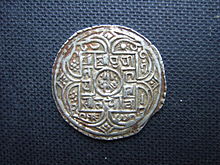Indian national calendar

The Indian national calendar, sometimes called the Saka calendar, is used, alongside the Gregorian calendar, by The Gazette of India, in news broadcasts by All India Radio and in calendars and communications issued by the Government of India.[1]
Originally through historical Indian influence, the Saka calendar is also used in Java and Bali among Indonesian Hindus. Nyepi, the "Day of Silence", is a celebration of the Saka new year in Bali. Nepal's Nepal Sambat evolved from the Saka calendar. The Saka calendar was also used in several areas in the modern-day Philippines as written in the Laguna Copperplate Inscription.
Calendar structure[]
The calendar months follow the signs of the tropical zodiac rather than the sidereal zodiac normally used with the Hindu and Buddhist calendars.
| # | Name (Sanskrit) | Length | Start date (Gregorian) | Tropical zodiac | Tropical zodiac (Sanskrit) |
|---|---|---|---|---|---|
| 1 | Chaitra | 30/31 | March 22/21 | Aries | Meṣha |
| 2 | Vaisākha | 31 | April 21 | Taurus | Vṛiṣabha |
| 3 | Jyēshtha | 31 | May 22 | Gemini | Mithuna |
| 4 | Āshādha | 31 | June 22 | Cancer | Karkata/Karka |
| 5 | Shrāvana | 31 | July 23 | Leo | Simha |
| 6 | Bhādra | 31 | August 23 | Virgo | Kanyā |
| 7 | Āshwin | 30 | September 23 | Libra | Tulā |
| 8 | Kārtika | 30 | October 23 | Scorpio | Vṛiśchika |
| 9 | Agrahāyana | 30 | November 22 | Sagitarius | Dhanur |
| 10 | Pausha | 30 | December 22 | Capricorn | Makara |
| 11 | Māgha | 30 | January 21 | Aquarius | Kumbha |
| 12 | Phālguna | 30 | February 20 | Pisces | Mīna |
Chaitra[2] is the first month of the calendar. Chaitra has 30 days and starts on March 22, except in leap years, when it has 31 days and starts on March 21. The months in the first half of the year all have 31 days, to take into account the slower movement of the sun across the ecliptic at this time.
The names of the months are derived from older, Buddhist lunisolar calendar, so variations in spelling exist, and there is a possible source of confusion as to what calendar a date belongs to.
The first day of the week is Ravivara (Sunday).[3] The official calendar reckoned by Govt. Of India has Sunday to Saturday as the week.[1]
| Weekday | Saka | Gregorian |
|---|---|---|
| 0 | Ravivara | Sunday |
| 1 | Somvara | Monday |
| 2 | Mangalavara | Tuesday |
| 3 | Budhavara | Wednesday |
| 4 | Brahaspativara | Thursday |
| 5 | Shukravara | Friday |
| 6 | Shanivara | Saturday |
Years are counted in the Saka era, which starts its year 0 in the year 78 of the Common Era. To determine leap years, add 78 to the Saka year – if the result is a leap year in the Gregorian calendar, then the Saka year is a leap year as well.
History[]
Vikram Period[]
This section needs expansion. You can help by . (January 2021) |
Kushana king Kanishka is believed to have created the calendar that came to be known as the Saka Calendar.
Adoption[]
Senior Indian Astrophysicist Meghnad Saha was the head of the under the aegis of the Council of Scientific and Industrial Research. Other members of the Committee were: A. C. Banerjee, K. L. Daftari, J. S. Karandikar, Gorakh Prasad, R. V. Vaidya and N. C. Lahiri. It was Saha's effort, which led to the formation of the Committee. The task before the Committee was to prepare an accurate calendar based on scientific study, which could be adopted uniformly throughout India. The Committee had to undertake a detailed study of thirty different calendars prevalent in different parts of the country. The task was further complicated by the integration of those calendars with religion and local sentiments. India's first prime minister, Jawaharlal Nehru, in his preface to the Report of the Committee, published in 1955, wrote: "They (different calendars) represent past political divisions in the country ... . Now that we have attained Independence, it is obviously desirable that there should be a certain uniformity in the calendar for our civic, social, and other purposes, and this should be done on a scientific approach to this problem."[4] Usage started officially at 1 Chaitra 1879, Saka Era, or 22 March 1957.
See also[]
- Astronomical basis of the Hindu calendar
- Bengali calendar, a related Indic calendar
- Hindu calendar
- History of calendars
- Indian New Year's days
- Kollam era the Malayalam calendar
- List of calendars
- Persian calendar
- Ritu (Indian season)
- Saka era
- Tamil calendar
- Vikram Samvat
- Bisuddhasiddhanta Panjika
References[]
- ^ a b "Gg Holiday Calendar". Govt. of India Official website.
- ^ "National Identity Elements - National Calendar - Know India: National Portal of India". knowindia.gov.in. Retrieved 2020-06-14.
- ^ a b Quint, The (22 March 2019). "Happy 'Saka' New Year 1941: Story Behind India's National Calendar". TheQuint. Retrieved 12 August 2020.
- ^ "Meghnad Saha, A Pioneer in Astrophysics". Vigyan Prasar Science Portal. Archived from the original on 23 February 2015.
- Sources
- Saha, M. N. (Chairman) (1955) Report of the Calendar Reform Committee New Delhi: Council of Scientific and Industrial Research
- Richards, Edward Graham (1998). Mapping Time: The Calendar and Its History (illustrated, reprint, revised ed.). Oxford University Press. pp. 184–185. ISBN 978-0-19-286205-1.
External links[]
- Indian culture
- National symbols of India
- Months of the Hindu calendar
- Time in India
- 1957 introductions
